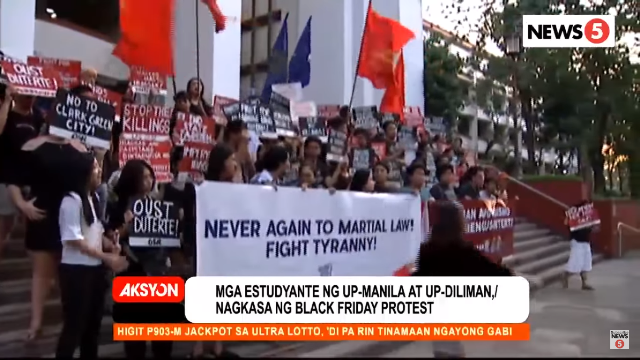“Red October” Plot: Some Journalists Asked the Hard Questions

Screengrab from Aksyon.
THERE WAS not much revealed during the president’s so-called “tete-a-tete” with his chief legal counsel, Sal Panelo, on September 11, including the president saying there was a plot to overthrow him. He had been saying the same thing since 2016. This time, however, he said the intelligence was from a foreign country. But on September 13, Defense Secretary Delfin Lorenzana said he knew nothing about such a plot. (See related monitor: “The Duterte Talk Show: Media Saw Through the Subterfuge”)
More than a week later on September 21, Brig. Gen. Antonio Parlade, assistant deputy chief of staff for operations of the Armed Forces of the Philippines (AFP) was more specific. He referred to “Red October”, saying they have verified information about the communists in connivance with opposition lawmakers and critical civic groups oust Duterte. Lorenzana agreed that such a plan existed.
On September 25, a raid on a farm in Teresa, Rizal by the National Bureau of Investigation (NBI) seized firearms. According to reports, the AFP was quick to link it to the plot. Brig. Gen. Arnulfo Marcelo Burgos Jr., commander of 202nd Infantry Brigade said that “The presence of top NPA leaders and the proximity of Teresa town to Manila are indicators that the threat of Red October cannot be downplayed and that the plotters are just awaiting an opportunity to execute their plans.”
Media reported that the NBI and the Philippine National Police (PNP) denied any connection between the incident and the plot.
On October 3, the AFP thickened the plot with its release to the press of a list of Manila-based universities where the Communist Party of the Philippines (CPP) is allegedly recruiting students. As proof, Parlade said there are on-going film showings regarding “dark years of martial law” which “incite students to rebel against the government.”
Media reported that a school in the list, “Caloocan City College,” does not even exist. Students, professors and school officials slammed the AFP for the accusation.
In covering an alleged ouster plot, it is important for the press to examine the basis and validity of the claim.
CMFR monitored primetime newscasts (ABS-CBN 2’s TV Patrol, GMA-7’s 24 Oras, TV5’s Aksyon, and CNN Philippines News Night) and the leading Manila broadsheets (Philippine Daily Inquirer, The Philippine Star and Manila Bulletin) from September 24 to October 2.
Two-Sided Approach
In covering “Red October”, media cited sources from the opposition, Liberal Party senators, representatives from the Magdalo group and the Makabayan bloc in the House; the civil society organization, Tindig Pilipinas, as well as the CPP. All denied there was a plot to oust government, with some saying that this was all meant to distract the nation from mounting problems, especially, inflation.
If the government claims there is a plot to oust the president from office, the media should ask for more evidence than just the claim of the military. There have been too many so-called revelations of coup attempts for the journalists to take just any claim seriously. Instead of merely repeating the statements of those talking about the plot and those who are debunking it, the media should also provide the critical facts that will help the public believe one claim against the other.
Validating Claims
Some columnists and political pundits did better to interpret what was going on. CMFR cheers those who weighed in with points that help the public evaluate the truth of the threat “Red October”.
In his “‘The Hunt for Red October’,” Inquirer columnist and retired general Ramon Farolan wrote that “First of all, there is nothing new or sinister about the CPP wanting to oust the President and overthrow his administration. For many years now, the armed wing of the CPP, known as the New People’s Army (NPA), has been waging war against every government that has ruled our land.”
“There are telltale signs that perhaps the plot is a work of fiction,” said Farolan, who pointed out that military units are not on heightened alert and that strict security measures are not in place.
“Under these circumstances, it is difficult not to suspect that Red October serves as a convenient distraction from the soaring costs of basic commodities and a declining peso. And it is the poor and lower classes of society that suffer the most,” Farolan concluded.
Political analyst Richard Heydarian echoed the same view — that there is nothing new about the CCP trying to win recruits for their purposes. In an interview on GMA-7’s morning show Unang Hirit, Heydarian said “Hindi naman nakakapagtaka na may plot ‘yung Communist Party kasi ang very reason of being po nila is to overthrow the Philippine government.”
CMFR cheers the efforts of anchor Karmina Constantino of ANC’s Dateline Philippines, who, during her September 25 newscast, asked Parlade the hard questions about the military allegation, saying “You have to give us a clearer picture here,” as she probed for more details about the supposed alliance of various groups to oust the president. Parlade failed to provide specific answers.
Constantino pressed further, questioning the basis presented by Parlade: “How did you go from legitimate dissent, legitimate criticisms against the government, legitimate opposition to destabilization?” Parlade said that it might have started during the martial law anniversary, when various anti-Duterte groups wanted to generate support for his ouster. Put in a spot, he had nothing more convincing to disprove that “Red October” was a red herring.
Now why can’t reporters ask the same questions when they sit at press conferences?
Leave a Reply